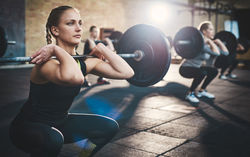
Imagine running at top speed while your right hand is almost touching the floor as you steer what amounts to a tray on runners down a slope. You then hurl your body into the air before landing in a lowered press-up position. From that point, your neck is taking all the strain as you hurtle down an icy slope for 50-55 seconds, reaching speeds of 130kph and forces of up to 5G.
Olympic efforts
This is the stress the British lugers (sliders) and Olympic medallists Lizzie Yarnold, Laura Deas and Dom Parsons put their bodies through every time they train or race.
Like all elite athletes, the training schedule for a skeleton or luge athlete is brutal. A budding Olympian will spend up to eight hours a day training in season, and six hours a day during the summer. A typical day starts with a weight lifting or a cardio workout followed by a few hours of sliding on the luge track.
So what does it take to be a skeleton athlete?
The best skeleton athletes are good sprinters with the ability to think and act quickly. A little extra weight helps, since heavier objects will fly down the track faster. However, weight in the form of lean muscle is more beneficial than fat. Many professional skeleton athletes have a background in track and field – Yarnold was a heptathlete before she took up the luge. Training for the sport involves a combination of sprints, weight training and plyometrics.
As a luge athlete, the goal is to lie on your stomach, head facing forward. Your toes should be kept back and slightly up, though you shouldn’t bend your knees to have you feet flying up in the air. Your chin should be up so you have to tilt you head up slightly.
Training to be a luge athlete
Each luge athlete has his or her own training schedule. The following is a guide to developing the muscles needed to become a champion luge athlete. Ask one of our personal training staff for help with any of the exercises mentioned below.
Day one – developing strength with heavy, slow lifts
Squats (with a weights bar) 5 x 8 reps
Lunges (holding dumbbells or with weights bar on shoulders) 5 x 8 reps
Bench press – 80-90 per cent of maximum weight – 5 x 4 reps
Day two – cardio training
Running – 45 minutes at steady pace or cycling 90-120 minutes at steady pace.
Day three – developing explosive power
Jumps – variety of jumping activities – tuck jumps, broad jump, jumping onto box top.
Cleans – using 50-60 per cent of maximum weight – 3 x 10-12 reps
Explosive lifts – 80-90 per cent of maximum weight – one lift, then return to floor and rest. Repeat 3 x 8 with break for stretching between each set.
Throughout training session, luge athletes must pay attention to their flexibility, with plenty of stretching work.
While the opportunities for luging in the UK are far and few, have a go at one of our luge training sessions. While doing so, just take a second to imagine what Yarnold, Deas and Parson put their bodies through. All at Kelsey Kerridge offer our huge congratulations to the GB Luge team.







